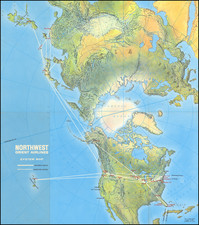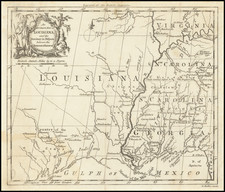Henri Chatelain's map of the inhabited parts of North America, based upon Nicholas De Fer's landmark four-sheet map published in 1718.
At the top left of the map is large-scale map of the Mississippi Delta and Mobile Bay, based upon the 1699 voyage of Pierre Le Moyne d'Iberville. The inset also appears on De Fer's rare 4 sheet map of 1718, upon which this map is based.
D'Ibeville explored the mouth of the Mississippi and its many tributaries, including the Red River in Arkansas. This map was first issued in Volume 6 of Chatelain's 7 volume Atlas Historique, published between 1705 and 1720. Heidenreich and Dahl surmised that the original 4-sheet De Fer map was issued to promoted the recently established Compagnie Francoise Occident and reinforce French opinion in the 1713 boundary settlement. The settlement was initially successful in promoting French emigration to America. However, the financing side of the company, conceived by John Law to help finance the debt left by Louis XIV, led to a wild burst of speculation and ultimate collapse. This episode is often referred to as the Mississippi Bubble.
Chatelain's one sheet version of De Fer's map proved very successful and was copied by Van Keulen and Ottens. The map includes a a nice plan and view of Quebec, and fine detail in the Great Lakes and Mississippi. The map features vignettes and notes throughout and a dozen sailing ships, Indian Villages, etc.
Henri Abraham Chatelain (1684-1743) was a Huguenot pastor of Parisian origins. Chatelain proved a successful businessman, creating lucrative networks in London, The Hague, and then Amsterdam. He is most well known for the Atlas Historique, published in seven volumes between 1705 and 1720. This encyclopedic work was devoted to the history and genealogy of the continents, discussing such topics as geography, cosmography, topography, heraldry, and ethnography. Published thanks to a partnership between Henri, his father, Zacharie, and his younger brother, also Zacharie, the text was contributed to by Nicolas Gueudeville, a French geographer. The maps were by Henri, largely after the work of Guillaume Delisle, and they offered the general reader a window into the emerging world of the eighteenth century.









![[ Michigan & 3 Great Lakes ] Amer. Sep. No. 42 Haut Canada Et Michigan](https://storage.googleapis.com/raremaps/img/small/98409.jpg)

![[Eastern Sheet -- Ohio] Post Road Map of the States of Ohio and Indiana with Adjacent Parts of Pennsylvania Michigan Illinois Kentucky and West Virginia Showing Post Offices With The Intermediate Distances and Mail Routes In Operation On the !st of February 1885 . . .](https://storage.googleapis.com/raremaps/img/small/44153.jpg)
![Carte De La Louisiane Et Du Cours Du Mississipi . . . Juin 1718 [1st State!]](https://storage.googleapis.com/raremaps/img/small/59797.jpg)

![[All The Way With LBJ - 1964 Presidential Election Campaign Poster] Johnson Humphrey for the USA](https://storage.googleapis.com/raremaps/img/small/88907.jpg)